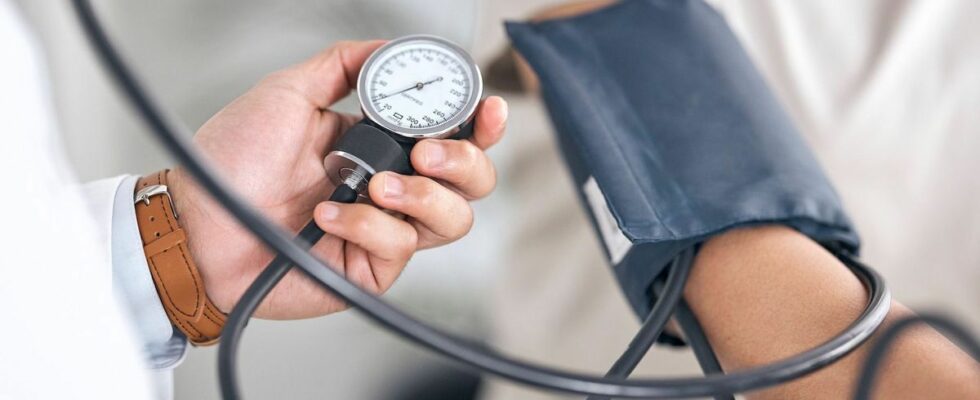Published on
updated on
Reading 3 min.
On August 31, the European Society of Cardiology published its new recommendations on high blood pressure. Simplified and more aggressive targets are among the important changes.
In the midst of a demographic expansion, high blood pressure (HBP) is a cause for concern, as it increases the cardiovascular risk of those affected. To better understand the problem, the European Society of Cardiology has therefore revised its recommendations, which it hopes will be simpler, but also more aggressive.
A new classification of blood pressure
A new classification is thus proposed. Hypertension remains defined by a blood pressure (BP) > 140/90 mmHg, but we are now talking about three levels:
- Non-high blood pressure (
- High blood pressure (between 120/70 and ;
- High blood pressure (above 140/90 mmHg).
This new classification allows us to react more quickly
- In case of confirmed non-elevated BP: there is no evidence to support antihypertensive treatment, healthy lifestyle should be encouraged and blood pressure should be reassessed in the future;
- In case of confirmed BP elevation: antihypertensive treatment may be indicated in a high-risk patient whose blood pressure remains above 130/80 mmHg despite hygiene and dietary rules;
- In case of confirmed HTA: Antihypertensive treatment is formally indicated, immediately, in parallel with hygiene and dietary rules.
The measurement must be more precise and standardized
Blood pressure measurement during consultation must meet certain standards to be reliable and reproducible.
- It should be carried out after 5 minutes in a seated position in a quiet environment, the cuff should be positioned at arm level and the arm should be supported so that muscle contractions do not alter the BP measurement;
- The measurements should be repeated three times and averaged.
“These constraints, which are not widely respected in daily practice, explain the major interest in measuring blood pressure outside the office” indicate the guidelines that indicate the standard rules to be applied.
- During the first consultation, it is therefore recommended to look for orthostatic hypotension in case of elevated blood pressure, high blood pressure or suggestive symptoms and to measure blood pressure with both arms in order to detect any possible difference;
- The pulse check should exclude possible arrhythmia. and assess heart rate. Indeed, most blood pressure measuring devices are not validated in cases of arrhythmia, and in this context, auscultatory measurement of blood pressure should be preferred;
- Finally the measurement must be carried out thanks to a validated armband (I/A) and adapted to the patient’s arm circumference. New technologies are emerging, such as wrist-based measuring devices. However, there is currently no scientific consensus on their use, and their use is therefore not recommended in practice at this time.
If hypertension is suspected, the diagnosis should be confirmed by self-measurement of blood pressure or by ambulatory blood pressure measurement (ABPM).
Cardiovascular risk research becomes priority
An assessment of cardiovascular risk must also be carried out quickly, in particular through the detection of diabetes, familial hypercholesterolemia or chronic renal failure. The aim of antihypertensive treatment is to reduce the overall cardiovascular risk. The higher the risk, the earlier, more intensive and more beneficial the treatment will be.
Opportunistic screening by office blood pressure measurement should be performed at least every 3 years before age 40 and every year after age 40 in patients at low or moderate cardiovascular risk.
More emphasis on hygiene and dietary measures
Hygiene and dietary rules play a crucial role in these recommendations both in the management of blood pressure control and in the broader benefit on cardiovascular health. These measures include
- A sodium restriction (but more recent data indicate the need to reduce this further due to the natural richness of the diet in potassium;
- Food balance and a healthy and balanced diet such as the DASH diet or the Mediterranean diet should be encouraged.
- Physical activity and the fight against a sedentary lifestyle are essential non-drug measures. The recommendations of practicing at least 150 minutes of moderate physical activity per week remain indicated, but 75 minutes of vigorous physical activity spread over three days can also be achieved.
The treatment envisaged remains the same
Drug treatment is indicated in case of high risk level: secondary prevention, heart failure, chronic kidney disease, diabetes, impact on target organs. The drug strategy is maintained in relation to the ESC 2018 guidelines with the immediate use of fixed dual therapy with 2 molecules among a RAAS blocker, a calcium channel blocker and a diuretic, and the possibility of switching to triple therapy in case of failure.

